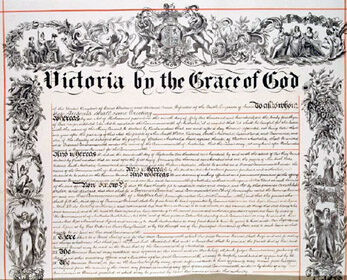
Letters Patent in the United Kingdom are legal instruments typically issued by the monarch.
These patents grant an office, right, title, or status to a person. They can also be used for the creation of different corporations or offices, granting city status, granting coat of arms, or for granting royal assent.
When a monarch pursues a Patent, there are three different documents involved. First is the Warrant, which contains The Queen’s instructions to the Lord Chancellor on preparing the Patent. The Lord Chancellor then gives these directions to the Crown Office, who is under the guidance of the Clerk of the Crown as the Patent is prepared.
Next is the Letters Patent, which is The Queen’s document that actually makes the appointment. Typed or handwritten on vellum, the Patent is sealed either by the Great Seal or the Wafer Great Seal. The third document involved is the Patent Roll entry. The Patent Roll serves as a record of the warrant and is bound together at the end of each regnal year. At the end of the regnal year, it is sent to the National Archives with other Warrants for permanent storage and retention.
These documents are not always given to the appointee. The Letters Patent comes at a cost for the appointee if they want an illustrated document prepared by scribes at the Crown Office. A text-only version can be obtained for free. The Patent Roll entry is exclusively held by the National Archives and is not given to the appointee.
Patents are prepared by the Crown Office and at the end of all documents is the name of the Clerk of the Crown in Chancery. The marking is a way to authenticate the documents passing through the Crown Office. The forms of Letters Patents disclosed by the office are known to be pro forma texts. That means the record provided satisfies minimum requirements and conforms to a doctrine or norm.
In the 20th century, most Patents are granted special conditions based on the appointment of individuals to office, allowing the holder to pick their successor. For example, a grant in reversion is granted to a person after the demise of the current holders; a grant in survivorship is granted to two people who hold the office collectively. Should one of these people die, the remaining party assumes office alone.
According to the Ministry of Justice, there are 92 unique types of letters, but in reality, there are much more than that. This is because the text can be altered for specific situations and are often used as a general basis for drafting.

